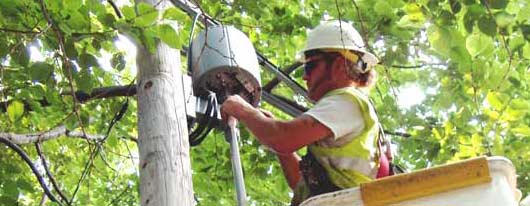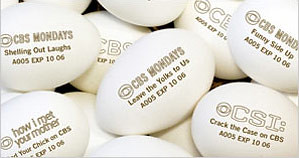
Worker adjusting the wireless access point outside my window.
Featured Tag: Wireless
Main Tags
art
blogging
learning
mac
movies
other
politics
science
tech
wireless
Tuesday, January 30, 2007
Ninth Ward awards Settanni Citizen of the Year
Minneapolis, MN
Ninth Ward Awards were handed out January 26 by Council Member Gary Schiff. Catherine Settanni received Citizen of the Year for her work on the Minneapolis community benefit agreement.
Congratulations Catherine!
Citizen of the Year: Catherine Settanni
Catherine Settanni led the charge to approve a tough community benefits agreement with US Internet's contract that establishes a city wireless network. Thanks to her work, USI will contribute half a million dollars of start up money, and millions more in future years to shrink the digital divide by contributing to community tech centers and free internet access in low income communities. The agreement is heralded nationally as a groundbreaking private-public partnership.
Monday, January 29, 2007
Wi-Fi Minneapolis: the new Ruckus gateway
Article at Earthtimes about the Ruckus Metroflex DZ.
MetroFlex DZ is a single device that gives subscribers wireless connectivity to outdoor broadband metro networks while simultaneously providing indoor Wi-Fi connectivity to home PCs and other Wi-Fi-enabled devices.
Travis Carter, VP of technology for US Internet, is quoted.
No pricing on the unit but I assume it will be cheaper than buying the old Ruckus and adding an internal wireless router.
Does anyone know when US Internet will be selling these?
Sunday, January 28, 2007
Downtown Minneapolis Wi-Fi ahead of schedule
Report in the Star Tribune by Steve Alexander: the Minneapolis Wi-Fi deployment is ahead of schedule and downtown residents will be able to purchase service in April or May instead of June.
It also says that US Internet has talked to St. Paul about either Wi-Fi or fiber optic deployment. (It's not clear in the article if it was one or both.) They haven't been asked to submit a proposal.
There's also this:
As part of the Minneapolis Wi-Fi construction, US Internet has been planning how to provide signals to buildings as tall as 30 stories and how to avoid interfering with existing networks inside Abbott Northwestern Hospital, Lange said.
That's Kurt Lange, VP of operations and customer service at US Internet. So do they have to provide the signal 30 stories up for no extra fees? That's the question. Sure seems that way from the quote.
The new Ruckus model is mentioned. It will have a wireless component so you won't have to tack on (and buy) another wireless router if you want Wi-Fi in your home. No price set. The current router with no internal Wi-Fi component is $75 or $5/month.
Monday, January 22, 2007
Janitors' union drops in on country club breakfast
About 40 members and supporters of the Twin Cities janitors union crashed a breakfast meeting of building owners Thursday morning at the Golden Valley Country Club, asking the building owners to intervene in the janitors' contract negotiations with cleaning companies.
Workday Minnesota
Curiously, StarTribune did not cover this story. Their last article on the janitors' union (Service Employees International Union Local 26 with 4,200 members) is here (sorry if it's disappeared behind the paywall). I found the Workday article via MNSpeak.
Sunday, January 21, 2007
iPhone Cingularity
The Clarion-Ledger out of Jackson, MS has a report that Apple's iPhone may not be available in areas without Cingular service due to a multi-year deal with AT&T-Cingular. That seems to be a significant portion of the country. (There's also the issue that Cingular's service sort of sucks. Could be a myth but I've heard it too many times to discount it completely.)
There is this little tidbit in the article:
Well, if you live in Minneapolis, MN, you could have wireless service via Wi-Fi within the city limits. (Not to mention that surrounding suburbs might cut reciprical deals so you could extend your Wi-Fi account throughout region.)A user could purchase an iPhone without activating the cell phone features, said Cingular's chief national spokesman, Mark Siegel, although he thought doing that wouldn't make much sense.
"It is meant to be a wireless phone," he said. "As a practical matter, you have to have wireless service."
So the question is can I buy an iPhone without a Cingular contract? I would not be able to use it as a cellphone but I could use it to make wireless calls over the Internet (VOIP).
Monday, January 15, 2007
The (Ad) Empire Strikes Back
 The monster known as Advertising Industry is howling. It exists only to be eyeballed and as our eyeballs have found more interesting content, it's importance diminishes along with its rates. Thus, we stamp the egg.
The monster known as Advertising Industry is howling. It exists only to be eyeballed and as our eyeballs have found more interesting content, it's importance diminishes along with its rates. Thus, we stamp the egg. That's eggs in supermarkets stamped with the names of CBS shows. How about selling ads on airline motion sickness bags (US Airways)? An article at the New York Times site discusses these and other curiousities of "alternative" or "out-of-home" advertising campaigns.
Marketers used to try their hardest to reach people at home, when they were watching TV or reading newspapers or magazines. But consumers' viewing and reading habits are so scattershot now that many advertisers say the best way to reach time-pressed consumers is to try to catch their eye at literally every turn.Really, advertisers don't have a clue as to how to reach me. It's definitely not with eggs and motion sickness bags. Please!
Anywhere the Eye Can See, It's Likely to See an Ad by Louise Story, NY Times, Jan 15, 2007
You can't reach me because I choose to ignore your pleas to buy. When I want something, I research what current customers say about your product and your competitors' product and then make a decision based on how well your product performs in the real world and often, how well your company performs in caring for customers (or keeping up the conversation, in Cluetrain terminology). Do you have an active Web presence ( not web site), for instance? Do you answer email in a reasonable amount of time? Do you contribute something of value to the Web?
The customer is marginalizing the advertising industry but it won't go away without a major battle as the NY Times article illustrates. Before it fades, our landscape will be saturated with ads. Luckily there is some pushback. From the article:
The trend may lead to more showdowns as civic pride is affronted. "They're making our community look like Las Vegas," said Barbara Thomason, president of the Houston Northwest Chamber of Commerce, of the scores of digital signs she has noticed popping up in the last few years. "The word 'trashy' has been used."
What the ad industry is not comprehending is that the Internet gives us better ways to choose products. We can aggregate buying reports globally via low-cost social software systems. Truly enlightened vendors can join these systems, openly and honestly, and we will give them our attention. These vendors can reduce their marketing and advertising budgets when they move into the new social space. In a sense, we will manage the vendors rather than let them attempt to manipulate us.
Remember Customer Relationship Management (CRM)? Let's call this Vendor Relationship Management or VRM.
Bonus link.
Saturday, January 13, 2007
Saturday Serendipity 2: David Byrne at NYT
Saturday is becoming the music post day as Roy once again sends me some musically-related link. Last Saturday, it was a Spike Jones video, this week it's a NY Times article about David Byrne by Will Hermes.
It's not an in-depth interview but definitely worth the read for those of us who aren't Byrne fanatics but buy his music faithfully and like to keep up with what he's doing.
His current project is Here Lies Love, a musical about Imelda Marcos.
A 1983 Letterman interview is mentioned in the Times piece. No link but I've dug it up for you. This is during the Talking Heads period and the group performs I Zimbra. Wretched video and audio quality but it's worth it to see Byrne's moves.
The article mentions Byrne's Journal but curiously ignores his web radio site.
Monday, January 08, 2007
Details on San Francisco Wi-Fi Deal
Last Friday, San Francisco and Earthlink penned an agreement to provide ubiquitous wireless access to the City, subject to approval by the Board of Supervisors. Glenn Fleishman at Wi-Fi Net News has a good analysis of the deal. Interesting point: he doesn't see Google mentioned.
For an exhaustive analysis and criticism of the deal, check out Esme Vos' take at MuniWireless. Esme also points out that this is far from a done deal even though the media seems to be playing it like it is.
Sunday, January 07, 2007
Wi-Fi in St. Paul: Public or Private?
Concordia College of Business and Organizational Leadership is hosting a free community discussion entitled: Should Wi-Fi in Saint Paul be publicly owned? It will take place on Jan. 17, 3:30 to 6 p.m. at Concordia's Library & Technology Center.
Here's more details and registration information. (You do need to register!)
Futurist Joel Barker will lead the discussion. He currently teaches at Concordia and will use a tool he created called the Implications Wheel which has a large crowd try to come up with all possible implications of a proposed idea or decision. It's related to James Surowiecki's book Wisdom of the Crowds.
St. Paul Pioneer Press has an article on Barker and the Wheel.
Saturday, January 06, 2007
Saturday Serendipity: Spike Jones and Big Mama Thornton
 Roy sent along a link to a Spike Jones music video posted at the News From Me site. No date on the video but the song, Cocktails for Two, was a big hit for Jones and the City Slickers in 1944. Spike is the bartender.
Roy sent along a link to a Spike Jones music video posted at the News From Me site. No date on the video but the song, Cocktails for Two, was a big hit for Jones and the City Slickers in 1944. Spike is the bartender. I started digging around. At Wikipedia I found an alternate video version of the same song.
 At YouTube, I found myself embedded in a world of nostalgic music videos and Big Mama Thornton sauntered in and started singing Hound Dog, the song she originally recorded in 1953, three years before Elvis P. sanitized it for white folk.
At YouTube, I found myself embedded in a world of nostalgic music videos and Big Mama Thornton sauntered in and started singing Hound Dog, the song she originally recorded in 1953, three years before Elvis P. sanitized it for white folk. Bonus Link: Alternate Hound Dog version.
Wednesday, January 03, 2007
Net Neutrality Editorial at NY Times
Protecting Internet Democracy - New York Times
This is a good call to arms about net neutrality. It does a good job of explaining the two-tier Internet that the Telcos and Cablecos want to impose.
But they call the AT&T-BellSouth merger a "limited but important victory for net neutrality" because AT&T was willing to concede a tiny bit. The reality of that deal is that AT&T will offer neutral slow broadband but have a more expensive higher speed service available that will not be neutral. Read Susan Crawford's analysis.
Bonus link: Esme Vos on the merger and how it could affect muni wi-fi.
Tuesday, January 02, 2007
Demolition of Guthrie Theater
Well, it's over. I think we should have kept it; it was a good performance space.
(found on flickr)
What's a placeblog?
I love that "random acts of journalism" part. Doesn't that describe Mainstream Media as well?
Placeblogger is a new site brought to you by the luminaries of citizen journalism: Lisa Williams, Jay Rosen, and Dan Gillmor.
Looks like listings are open to the public.
Read the rest of the "What a...?" page. It's a great description of what this type of blog is about. With the new municipal wireless system coming to Minneapolis, I hope we will see more 'placeblogs' and maybe even some neighborhood projects to get them going.
MNSpeak, our own hyperlocal blogging device (or whatever), is listed at #9 in the realm of placeblogs.
Power Distribution to be like Telecom Distribution
This is pretty funny. (Or depressing if you have a really fatalistic view of where we're headed.)
Thanks to Doc.
Agile guy podcast
Redefining Software Engineering over at IT Conversations is a chat with Alistair Cockburn, one of the creators of the Agile Development Manifesto for software creation.
Bonus link: Phil Windley's Technometria blog.
Forget Wii. Check the next gen
I might stand in line for this one. Kick Ass Kung Fu.
This is from New Scientist's The Year in Video which also includes an octopus camouflaged as a plant, and an intestinal robot.
Law of Physics limits credit card data storage to three months
As one year passes and the new one begins, Mary and I are trying to figure out how to track credit card expenses. I want to avoid having to type all the transactions into Quicken.
Last night I finally figured out how to transfer credit card transaction data from my Credit Union's (City County Federal) online system to Quicken 98 (within Classic on my OS X Mac). (I'll post the details of how I did that below.) That's a huge step.
But I'm behind in tracking statements and needed data back through September. That's four statements back and the system only gives me three.
Sigh. I called the Credit Union to complain. Three statements is basically three months and not much of a history. I wanted to know who decided this arbitrary limit and I was hoping they might have access to a digital version that they could share with me.
Ah ha. The limit's not imposed by my CU. In fact, if they want to delve beyond three statements, they have to go to CD backup disks. They can't share those discs with me because it contains multiple users' data.
The CU told me to talk to PSCU Financial Services about it. They run the back-end services for credit unions. (PSCU stands for "Payment Processing Services for Credit Unions, I was told.)
I called and talked to Kevin at PSCU. He told me it's a system limit of some kind, and told me this in a way that made it sound like a law of physics (The Three-Month Statement Barrier?). I just said they need to buy more hard drives and storage is cheap these days.
The reality is more complex, of course. Lana at my CU, who handles the Visa department, said that it's in the works to provide a longer historical range. All the CUs want it. But there is a monolithic software application on the back-end and it's going to take a while.
I suggested that besides just talking to CUs, she also talk to users like me about how we want to use and view our data. I'd like to be able to categorize online and sort in different ways. I'd like to get some charts illustrating spending habits. And I'd like an XML feed of all the data so I can do whatever I want with it and take it with me if I move to another bank or credit card vendor.
Let's file this under Vendor Relationship Management with a tip of the hat to Doc Searls.
The Details of How I Did It
As promised, the details on how I moved the credit card data download file into Quicken 98 running on my OS X Mac via Classic.
First, PSCU offers a QIF (or Quicken Interchange Format) file. So if you don't have access to that, check this page and maybe you can format a text file to be a QIF file. Good luck.
Second, download the .QIF file and if it comes over as ".qif" change it to ".QIF". (I don't really know if this matters or not but I may have read it somewhere.)
At this point, Quicken can't see the file on my system. I think it may be due to some of the file conversion settings that are default in OS 9 Classic. I went to change this -- there's a control panel called File Exchange or something -- but Classic doesn't allow you to use that particular control panel. At this point, I thought my quest had ended and it would be back to typing the data. Read on...
Third, open the .QIF file in a text editor (as it is a text file). I used BBEdit. I assume TextEdit will work (make sure you are working with text and not RTF). "Save as..." a text file with the .QIF extension. Quicken can see this file.
Fourth, open the Quicken 98, open the account that you wish to import to, and go to the File menu and select "Import." You should see the file. Select and import. You may get an error right at the start about having a problem with something or other but there is a "Continue" button that will allow the import to go on.
The data is ugly and won't have any categories, of course. Payee names are in all-caps and truncated to fit the field in Quicken. The memo field has some ID transaction number. (Maybe they can make the data prettier when they upgrade the system.)
You can enter categories quickly without touching the mouse. Enter the category, press the Enter key twice to accept it and move to the next transaction, then press the down arrow key twice to place the cursor in the next category field. Make sure auto-complete is on in your prefs so you don't have to type the whole category name.
That does it for this post. Happy New Year!


